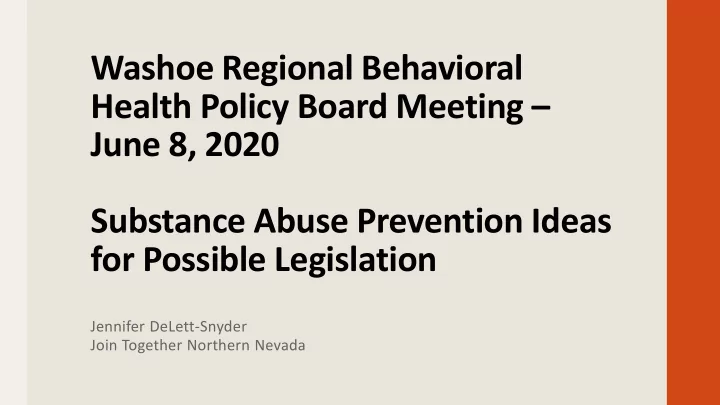

Washoe Regional Behavioral Health Policy Board Meeting – June 8, 2020 Substance Abuse Prevention Ideas for Possible Legislation Jennifer DeLett-Snyder Join Together Northern Nevada
Discussion of Five Ideas 2
1) Nevada Youth Risk Behavior Survey (YRBS ) Voluntary survey completed by middle and high school students every two years Data is used to inform decisions in counties across the state to address health- risk behaviors, obtain grant funding, better inform policy, etc. Nevada sets a minimum response rate of 60 percent to ensure YRBS data are representative Active vs. Passive Consent Currently 6 of Nevada’s 16 counties require active consent from parents 2017 high school YRBS response rate range: passive consent - 71.4-91.3% active consent – 39.6-80.9% Lowest response rate in 2019 was 11.3% in an active consent community 3
Active vs. Passive Consent continued No mandatory policy from the Department of Education directing schools to conduct the parental consent in a standardized manner Each school district’s superintendent determines whether to have active or passive consent Nevada communities have lost federal funding due to not having consistent data related to the four core measures required by certain grants. 30-day alcohol, tobacco, and other drug use Perceptions of risk Perceptions of parental disapproval Perceptions of peer disapproval YRBS currently includes the four core measures but districts with active consent do not always reach the minimum response rate Suggested Solution Legislation to allow standardized passive consent policies statewide – this action would still allow parents to opt out 4
2) Revision to Existing Bill – AB114 • Suicide prevention education bill that requires the board of trustees of each school district to submit to the Department of Education the curriculum used to teach students about suicide prevention, training for teachers and administrators, and incidents of suicide, attempted suicide, and suicidal ideation. Suggested Modifications 1) Require reporting of evidence-based programs used by the school district to deliver substance abuse prevention education 2) Mandate the Nevada Department of Education to put forth a list of substance abuse evidence-based screening and assessment tools for use by school districts 5
3) Create a Bill Similar to AB114 for Substance Abuse Prevention Use similar language Allow for flexibility Mandate the Nevada Department of Education to put forth a list of substance abuse evidence-based screening and assessment tools for use by school districts Screening could be part of restorative discipline practice Example: If a student is found with a vape pen or other drug paraphernalia, the student would be screened prior to any discipline. 6
4) Substance Abuse Prevention Coalitions Coalitions with a primary focus of substance abuse were formalized in the early 2000s to represent all Nevada counties. Coalitions were created to facilitate local level decision-making related to the delivery of prevention programs and strategies. Coalition key stakeholders are engaged to make data driven decisions that best serve their communities. Additionally, coalitions stay abreast of emerging trends related to substance misuse and mobilize quickly to address these issues. Currently coalitions are addressed in NRS 458.025 in an opaque manner. 7
Coalitions continued NAC 458.0235 defines coalition program to mean “a program that is operated by a nonprofit organization consisting of individuals, organizations and agencies to develop strategies and identify programs which address the needs of a community or of a racial, ethnic, religious or social group regarding the use of, misuse of and dependence on alcohol and other drugs in that community or group.” Reviewed the statutes relating to the establishment of potentially similar entities - Regional Behavioral Health Policy Boards and Family Resource Centers Suggested Solution Due to the work conducted in the communities by the coalitions, it would make sense for the coalitions to be institutionalized in the prevention structure of the state. 8
5) Kratom - mitragynine • An herb found in Southeast Asia that has become popular in Western society as a mind- altering substance • Bonds to the same receptors in the brain as morphine – 13x more potent than morphine • Has properties that can lead to abuse and addiction – in small doses acts like a stimulant; in large doses acts like a sedative • DEA drug of concern • Sold in smoke shops and other stores in Nevada • Marketed as a safer alternative to opioids, herbal supplement, organic, farm-fresh, natural • No FDA-approved uses • Washoe County Medical Examiner’s Office has reported deaths due mitragynine during the past 2 years Suggested Solution • Work with legislators and the Board of Pharmacy to schedule mitragynine and make it illegal to sell in 9 Nevada
Questions and Feedback Contact Information Jennifer DeLett-Snyder jennifer@jtnn.org 775-324-7557 10
Recommend
More recommend